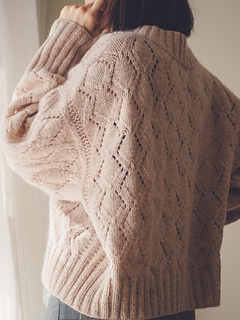patterns >  Irene Lin Designs
Irene Lin Designs
> Gem Sweater













Gem Sweater
The Gem Sweater is knitted by starting at the back from the top down to the base of the armholes. Then, both fronts are picked up and knitted separately, working from the top down to the edge of the front neck. After joining both pieces, the front is worked to the armhole, and then the front and back are joined and knitted in the round down to the hem. Pick up and knit for the sleeves.
Gauge / With 5 mm (US 8) needle :
17 sts x 24 rows = 10 x 10 cm / 4 x 4” in stockinette stitch after blocking.
18 sts x 24 rows = 10 x 10 cm / 4 x 4” in pattern stitch after blocking.
Size:
1 (2, 3, 4)(5, 6, 7) Sample is shown in size 1, and with 44
cm/17.25” positive ease.
Finished body circumference:
127 (136, 150, 158)(172, 181, 190)cm/50 (53.5, 59, 62)(67.75, 71.25, 74.75)”
Yarn:
The sample is knitted with one strand of lace weight yarn (Mohair) and one strand of sport weight yarn held together. It’s also good to use one strand of worsted weight yarn for this sweater.
-De Rerum Natura Bérénice, 55% Mohair, 25% Silk, 20% Merino, 25g=230yd/210m.
Sample photo shown in Size 1 with Color Avoine
5.5 (6, 7, 8)(9, 10, 11) Balls. Approx. 1155 (1260, 1470, 1680)(1890, 2100, 2310) m / 1265
(1380, 1610, 1840)(2070, 2300, 2530) yards.
-De Rerum Natura Ulysse, 100% merino, 50g=202yd/185m.
Sample photo shown in Size 1 with Color Quartz
6.5 (7, 8, 9)(10, 11, 12) Balls. Approx. 1202 (1295, 1480, 1665)(1850, 2035, 2220 ) m / 1313
(1414, 1616, 1818)(2020, 2222, 2424) yards.
Needles:
5 mm (US 8) for the body. 4 mm (US 6) for the collar, hem and cuffs. (Use circular needles ranging from 60 to 120 cm according to the requirements of each section; DPNs or preferred needles (Magic Loop) for small circumference knitting)
Other Materials:
Stitch markers, waste yarn.
Video support:
Backwards loop cast-on method
17433 projects
stashed
12580 times
1656 projects
stashed
977 times
- First published: February 2024
- Page created: February 15, 2024
- Last updated: March 22, 2024 …
- visits in the last 24 hours
- visitors right now




